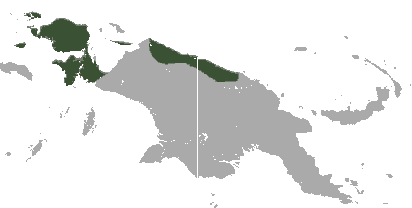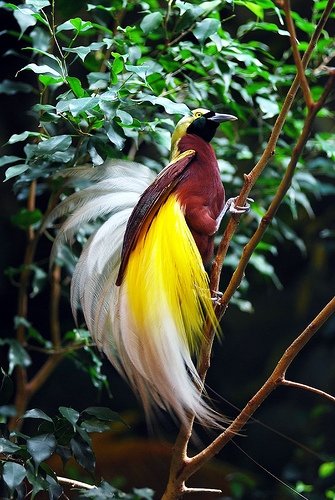|
Goodfellow's Tree-kangaroo
Goodfellow's tree-kangaroo (''Dendrolagus goodfellowi''), also called the ornate tree-kangaroo, is an endangered, long-tailed mammal native to rainforests of New Guinea. Like most tree-kangaroos (genus '' Dendrolagus''), it lives in the treetops and feeds on leaves or other plant matter. It belongs to the macropod family ( Macropodidae) along with kangaroos, and carries its young in a pouch like other marsupials. Its main threats are habitat loss and hunting. There are two subspecies: ''D. g. goodfellowi'' and ''D. g. buergersi'' (known as Buergers' tree-kangaroo). Name and taxonomy The species name ''goodfellowi'' is in honour of British zoological collector Walter Goodfellow. There are two subspecies of the Goodfellow's tree-kangaroo: * ''Dendrolagus goodfellowi goodfellowi'' * ''Dendrolagus goodfellowi buergersi'' – Buergers' tree-kangaroo Description Like other tree-kangaroos, Goodfellow's tree-kangaroo is quite different in appearance from terrestrial kangaroos. Un ... [...More Info...] [...Related Items...] OR: [Wikipedia] [Google] [Baidu] |
Tree-kangaroo
Tree-kangaroos are marsupials of the genus ''Dendrolagus'', adapted for arboreal locomotion. They inhabit the tropical rainforests of New Guinea and far northeastern Queensland, Australia along with some of the islands in the region. All tree-kangaroos are considered threatened due to hunting and habitat destruction. They are the only true arboreal macropods. Evolutionary history The evolutionary history of tree-kangaroos possibly begins with a rainforest floor-dwelling pademelon-like ancestor. This ancestor possibly evolved from an arboreal possum-like ancestor as is suspected of all macropodid marsupials in Australia and New Guinea. During the late Eocene, the Australian/New Guinean continent began a period of drying that caused a retreat in the area of rainforest, which forced the ancestral pademelons to begin living in a drier, rockier environment. After some generations of adaptation to the new environment, the pademelons may have evolved into rock-wallabies (''Petr ... [...More Info...] [...Related Items...] OR: [Wikipedia] [Google] [Baidu] |
Oldfield Thomas
Michael Rogers Oldfield Thomas (21 February 1858 – 16 June 1929) was a British zoologist. Career Thomas worked at the Natural History Museum, London, Natural History Museum on mammals, describing about 2,000 new species and subspecies for the first time. He was appointed to the museum secretary's office in 1876, transferring to the zoological department in 1878. In 1891, Thomas married Mary Kane, daughter of Sir Andrew Clark, 1st Baronet, Sir Andrew Clark, heiress to a small fortune, which gave him the finances to hire mammal collectors and present their specimens to the museum. He also did field work himself in Western Europe and South America. His wife shared his interest in natural history, and accompanied him on collecting trips. In 1896, when William Henry Flower took control of the department, he hired Richard Lydekker to rearrange the exhibitions, allowing Thomas to concentrate on these new specimens. Thomas viewed his taxonomy efforts from the scope of British impe ... [...More Info...] [...Related Items...] OR: [Wikipedia] [Google] [Baidu] |
Flindersia Pimenteliana
''Flindersia pimenteliana'', commonly known as maple silkwood, red beech or rose silkwood, is a species of tree in the family Rutaceae and is Indigenous (ecology), native to New Guinea and Queensland. It has Pinnation, pinnate leaves with three to seven egg-shaped to elliptic leaflets, panicles of red or reddish flowers and fruit studded with rough points. Description ''Flindersia pimenteliana'' is a tree that typically grows to a height of . It has pinnate leaves long arranged in more or less opposite pairs with three to seven, egg-shaped to elliptic leaflets long and wide. The side leaflets are on a Petiole (botany), petiolule long and the end leaflet on a petiolule long. The flowers are arranged in panicles long, the five sepals about long and the five petals red or reddish and long. Flowering occurs from November to February and the fruit is a woody Capsule (botany), capsule long and studded with rough points up to long. The fruit opens into five valves, releasing ... [...More Info...] [...Related Items...] OR: [Wikipedia] [Google] [Baidu] |
Endangered Fauna Of Oceania
An endangered species is a species that is very likely to become extinct in the near future, either worldwide or in a particular political jurisdiction. Endangered species may be at risk due to factors such as habitat loss, poaching, invasive species, and climate change. The International Union for Conservation of Nature (IUCN) Red List lists the global conservation status of many species, and various other agencies assess the status of species within particular areas. Many nations have laws that protect conservation-reliant species which, for example, forbid hunting, restrict land development, or create protected areas. Some endangered species are the target of extensive conservation efforts such as captive breeding and habitat restoration. Human activity is a significant cause in causing some species to become endangered. Conservation status The conservation status of a species indicates the likelihood that it will become extinct. Multiple factors are considered when ... [...More Info...] [...Related Items...] OR: [Wikipedia] [Google] [Baidu] |
Mammals Of Western New Guinea
A mammal () is a vertebrate animal of the class Mammalia (). Mammals are characterised by the presence of milk-producing mammary glands for feeding their young, a broad neocortex region of the brain, fur or hair, and three middle ear bones. These characteristics distinguish them from reptiles and birds, from which their ancestors diverged in the Carboniferous Period over 300 million years ago. Around 6,640 extant species of mammals have been described and divided into 27 orders. The study of mammals is called mammalogy. The largest orders of mammals, by number of species, are the rodents, bats, and eulipotyphlans (including hedgehogs, moles and shrews). The next three are the primates (including humans, monkeys and lemurs), the even-toed ungulates (including pigs, camels, and whales), and the Carnivora (including cats, dogs, and seals). Mammals are the only living members of Synapsida; this clade, together with Sauropsida (reptiles and birds), constitutes the lar ... [...More Info...] [...Related Items...] OR: [Wikipedia] [Google] [Baidu] |
Marsupials Of New Guinea
Marsupials are a diverse group of mammals belonging to the infraclass Marsupialia. They are natively found in Australasia, Wallacea, and the Americas. One of marsupials' unique features is their reproductive strategy: the young are born in a relatively undeveloped state and then nurtured within a pouch on their mother's abdomen. Extant marsupials encompass many species, including kangaroos, koalas, opossums, possums, Tasmanian devils, wombats, wallabies, and bandicoots. Marsupials constitute a clade stemming from the last common ancestor of extant Metatheria, which encompasses all mammals more closely related to marsupials than to placentals. The evolutionary split between placentals and marsupials occurred 125-160 million years ago, in the Middle Jurassic-Early Cretaceous period. Presently, close to 70% of the 334 extant marsupial species are concentrated on the Australian continent, including mainland Australia, Tasmania, New Guinea, and nearby islands. The remainin ... [...More Info...] [...Related Items...] OR: [Wikipedia] [Google] [Baidu] |
Macropods
Macropod may refer to: * Macropodidae, a marsupial family which includes kangaroos, wallabies, tree-kangaroos, pademelons, and several others * Macropodiformes The Macropodiformes , also known as macropods, are one of the three suborders of the large marsupial order Diprotodontia. They may in fact be nested within one of the suborders, Phalangeriformes. Kangaroos, wallabies and allies, bettongs, p ..., a marsupial suborder which includes kangaroos, wallabies and allies, bettongs, potoroos, and rat kangaroos See also * '' Macropodia'', genus of crabs * Megapode, chicken-like birds in the family ''Megapodiidae'' {{disambiguation Animal common name disambiguation pages ... [...More Info...] [...Related Items...] OR: [Wikipedia] [Google] [Baidu] |
Fauna Of Indonesia
The fauna of Indonesia is characterised by high levels of biodiversity and endemicity due to its distribution over a vast tropical archipelago. Indonesia divides into two ecological regions; western Indonesia which is more influenced by Asian fauna, and the east which is more influenced by Australasian species. The Wallace Line, around which lies the Wallacea transitional region, notionally divides the two regions. There is diverse range of ecosystems, including beaches, sand dunes, estuaries, mangroves, coral reefs, sea grass beds, coastal mudflats, tidal flats, algal beds, and small island ecosystems. Environmental issues due to Indonesia's rapid industrialisation process and high population growth, have seen lower priority given to preserving ecosystems. Issues include illegal logging, with resulting deforestation, and a high level of urbanisation, air pollution, garbage management and waste water services also contributing to the forest deterioration. The widespread defor ... [...More Info...] [...Related Items...] OR: [Wikipedia] [Google] [Baidu] |
Fauna Of New Guinea
The fauna of New Guinea comprises a large number of species of mammals, reptiles, birds, fish, invertebrates and amphibians. As the world's largest and highest tropical island, New Guinea occupies less than 0.5% of world's land surface, yet supports a high percentage of global biodiversity. Approximately 4,624 vertebrate species inhabit the island of New Guinea and its surrounding waters, which constitutes about 8% of the recognized world vertebrates. This ranges from an estimated 4% of the world's lizards and mammals, to about 10% of the world's fish species. The numbers of global and New Guinea invertebrate species are poorly known, and thus an accurate comparison is difficult. Butterflies are the best known invertebrate group, and are represented in New Guinea by about 735 species, which is about 4.2% of the world total of 17,500 species. Nevertheless, despite the rich biodiversity, New Guinea's megafauna diversity is quite low since the Pleistocene extinction event, especial ... [...More Info...] [...Related Items...] OR: [Wikipedia] [Google] [Baidu] |
Ruminant
Ruminants are herbivorous grazing or browsing artiodactyls belonging to the suborder Ruminantia that are able to acquire nutrients from plant-based food by fermenting it in a specialized stomach prior to digestion, principally through microbial actions. The process, which takes place in the front part of the digestive system and therefore is called foregut fermentation, typically requires the fermented ingesta (known as cud) to be regurgitated and chewed again. The process of rechewing the cud to further break down plant matter and stimulate digestion is called rumination. The word "ruminant" comes from the Latin ''ruminare'', which means "to chew over again". The roughly 200 species of ruminants include both domestic and wild species. Ruminating mammals include cattle, all domesticated and wild bovines, goats, sheep, giraffes, deer, gazelles, and antelopes.Fowler, M.E. (2010).Medicine and Surgery of Camelids, Ames, Iowa: Wiley-Blackwell. Chapter 1 General Biology and ... [...More Info...] [...Related Items...] OR: [Wikipedia] [Google] [Baidu] |





